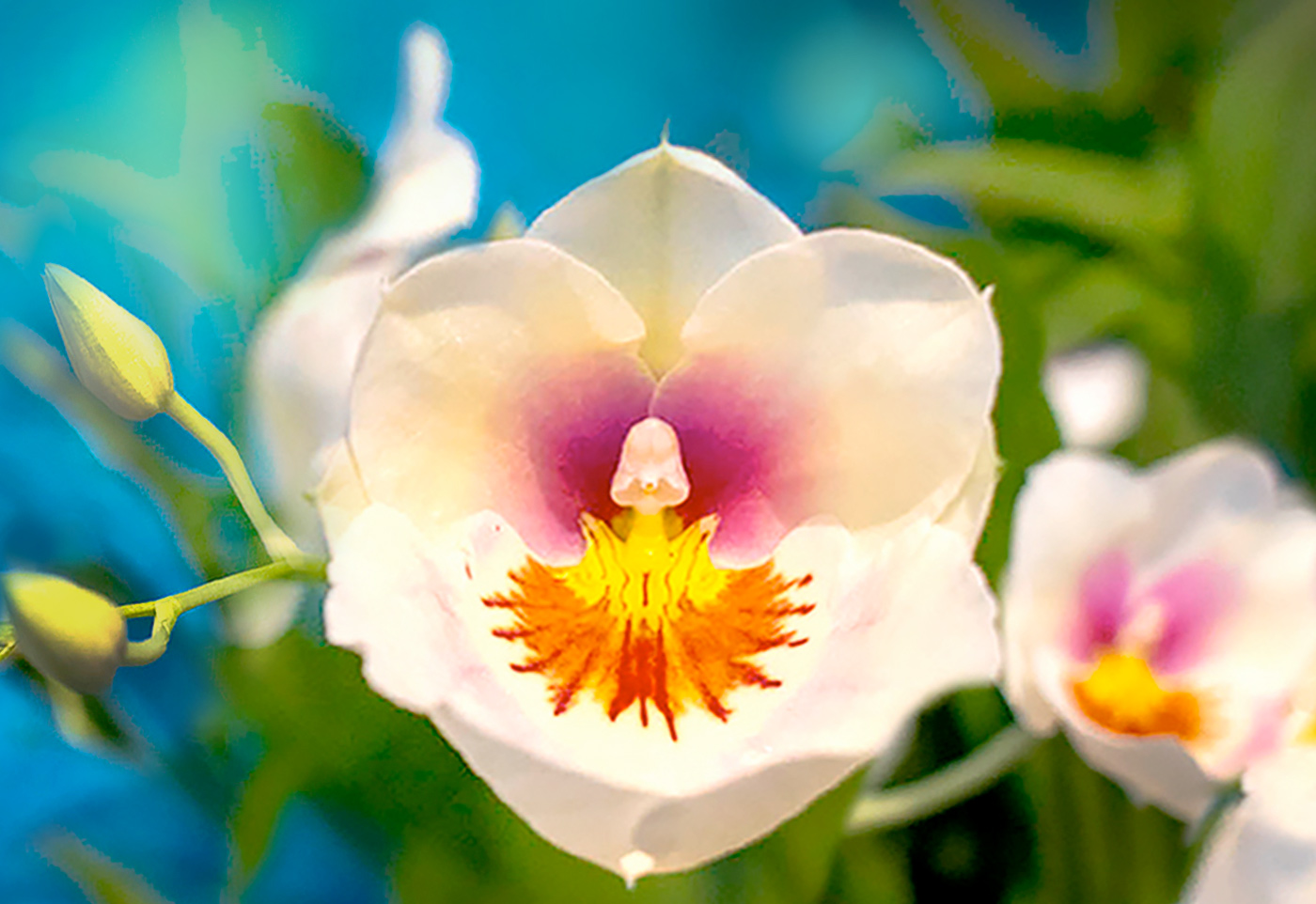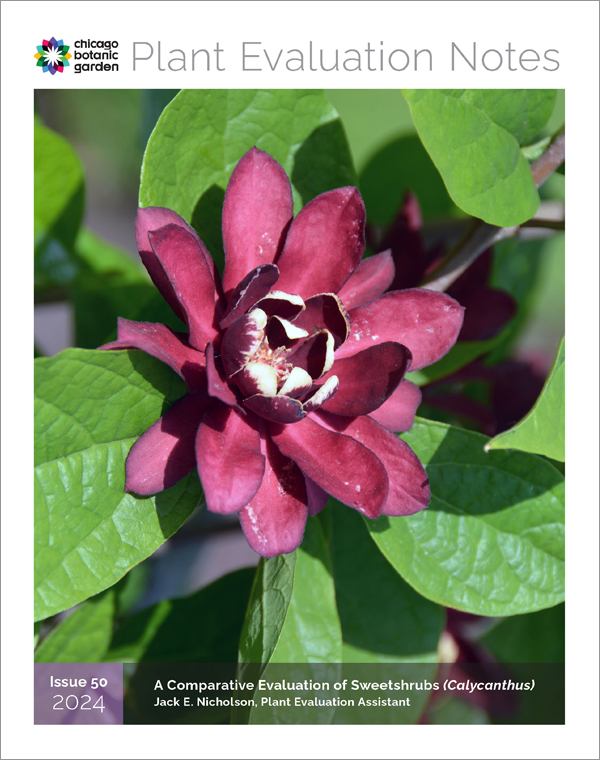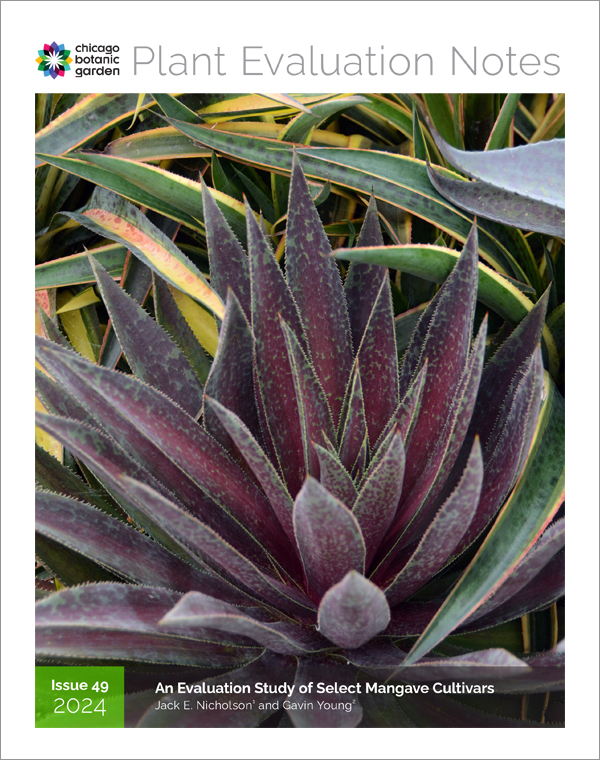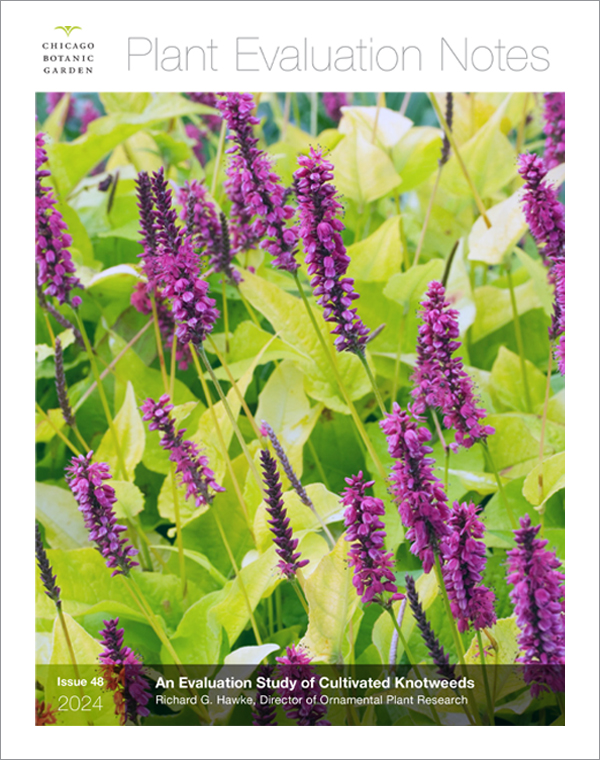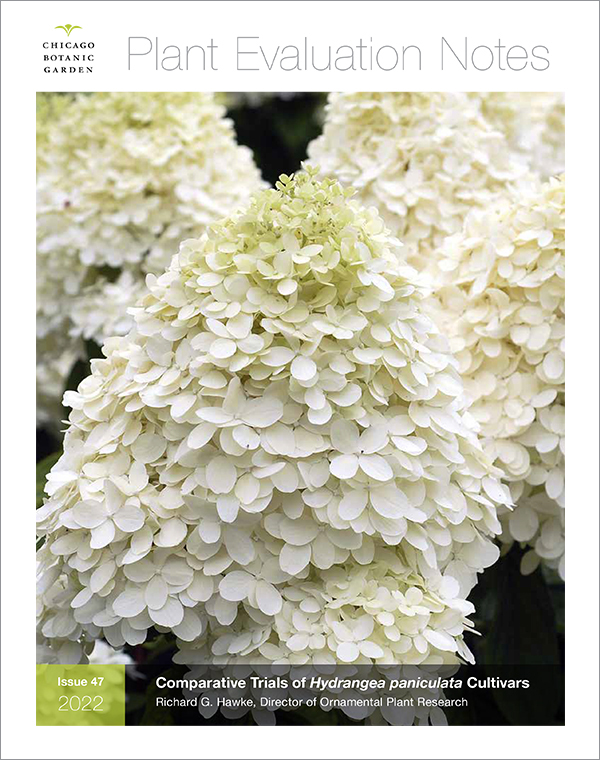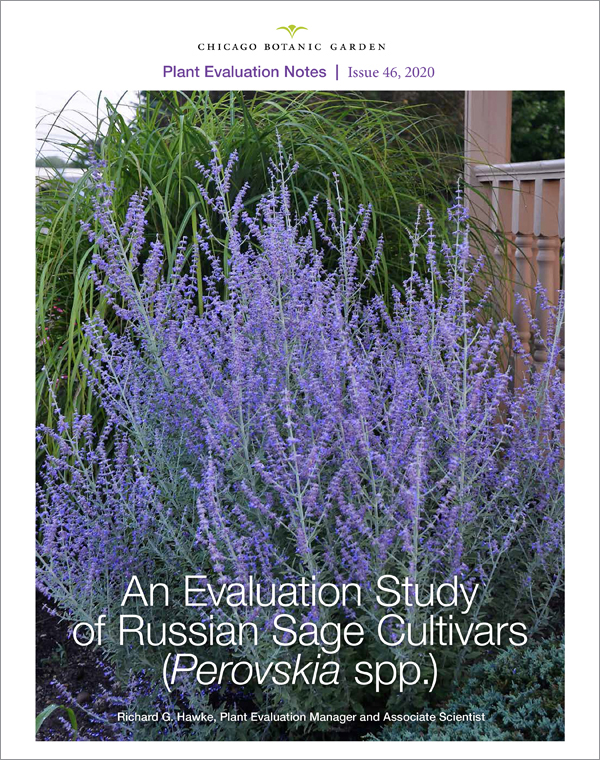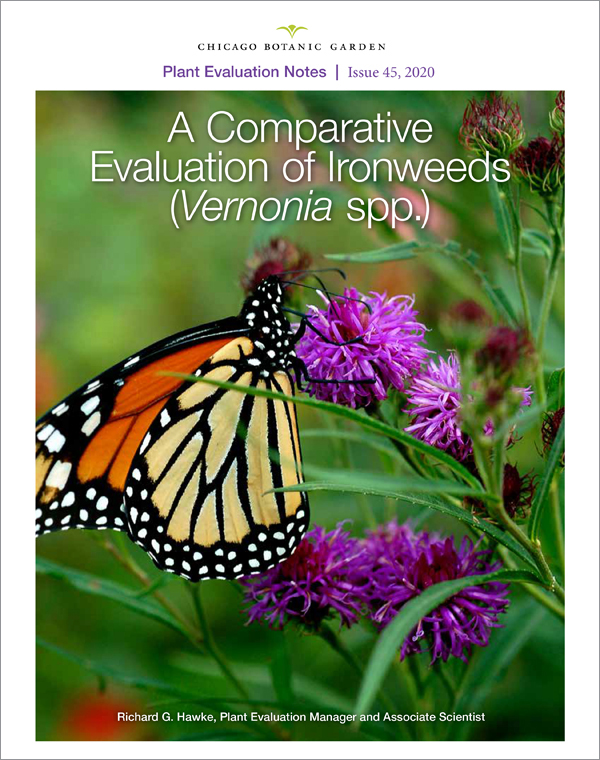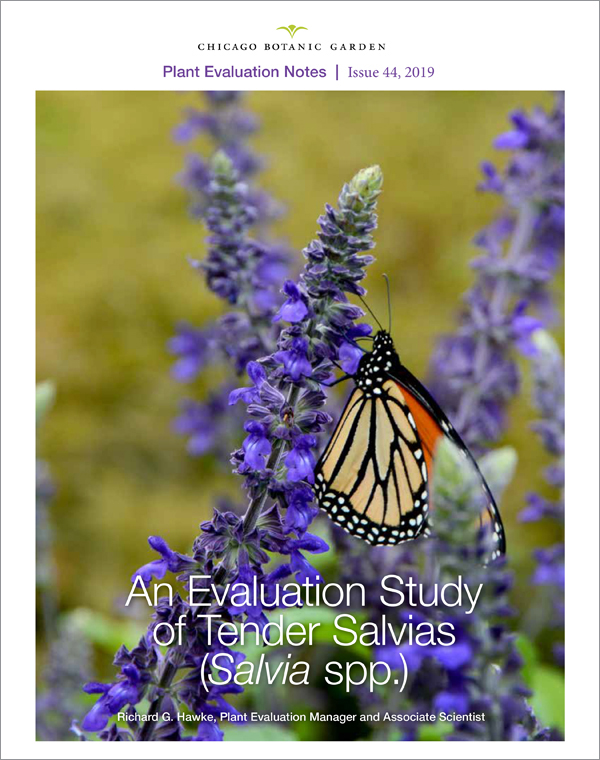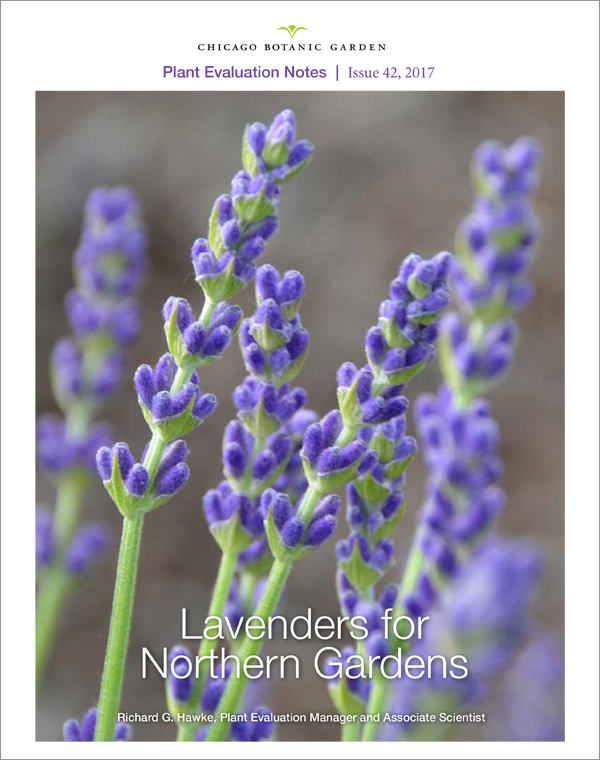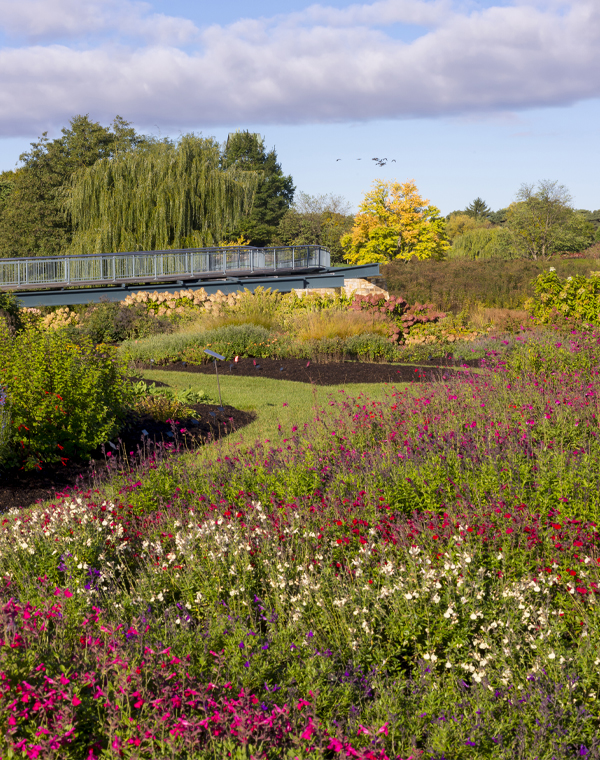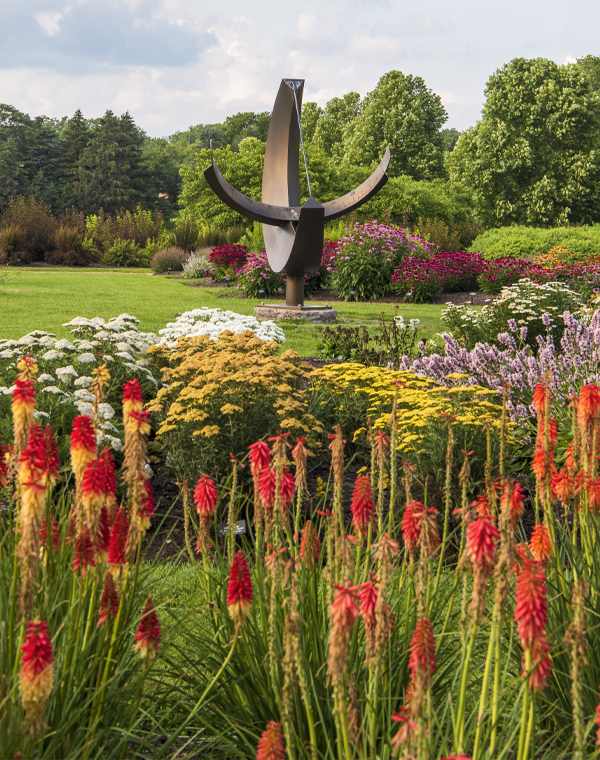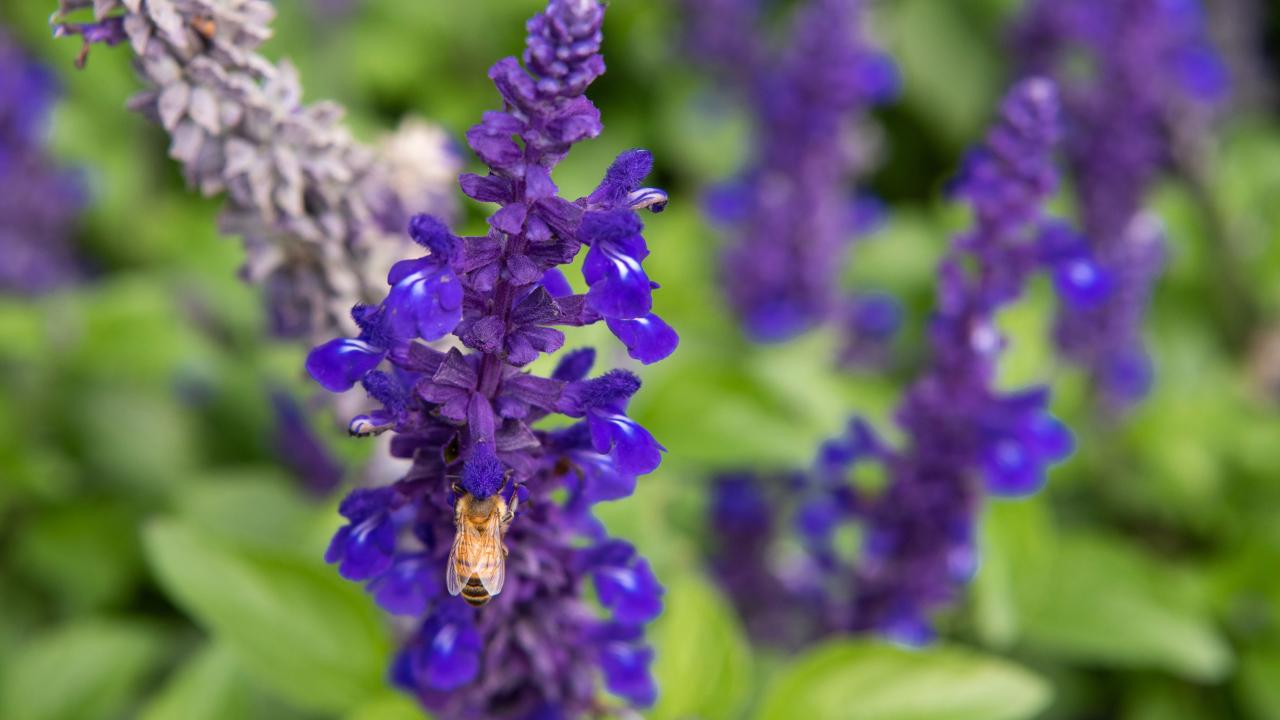

Plant Evaluation
Plant Evaluation
The program evaluates herbaceous and woody plants in comparative trials, ultimately recommending the top performers to gardeners and the horticultural industry. More than 800 taxa are currently evaluated in the Bernice E. Lavin Plant Evaluation Garden, Mitsuzo and Kyoko Shida Evaluation Garden, and the Green Roof Gardens.
Twenty-six comparative trials are currently underway, including trials in the Shida Evaluation Garden featuring abelias (Abelia), bugleweeds (Ajuga), bergenias (Bergenia), sedges (Carex), clematis (Clematis), hellebores (Helleborus), coral bells (Heuchera), rose of Sharon (Hibiscus syriacus), smooth hydrangeas (Hydrangea arborescens), and lungworts (Pulmonaria). Ongoing trials in Lavin Plant Evaluation Garden include bluestars (Amsonia), fall anemones (Anemone), masterworts (Astrantia), false indigos (Baptisia), butterfly bushes (Buddleja), hardy mums (Chrysanthemum), larkspurs (Delphinium), tufted hair grasses (Deschampsia), rose mallows (Hibiscus), torch lilies (Kniphofia), spring phloxes (Phlox), ninebarks (Physocarpus), burnets (Sanguisorba), rosinweeds (Silphium), goldenrods (Solidago), and umbellifers.
The All-America Selections Perennials Trial are in the Lavin Evaluation Garden; AAS winners have been tested nationally and proven locally. The Shida Evaluation Garden houses the shrub rose trials in collaboration with the American Rose Trials for Sustainability® program. The goal of this national program is to identify, through regional evaluation and testing under low-input conditions, the most disease- and pest-resistant, hardiest, and most garden-worthy rose cultivars, and to provide objective, accurate, and reliable information about the cultivars tested for each region to industry professionals and the gardening public.
Trial results are published in Plant Evaluation Notes, which is a Chicago Botanic Garden publication, Fine Gardening magazine, and other horticultural and green industry publications and websites. Plant Evaluation Notes are currently published online.
Plant Collections
Living Plant Documentation
Curation
Ornamental Plant Research
Plant Breeding
Plant Evaluation
Chicagoland Grows® Plant Introduction Program
Bonsai Collection
Orchidarium
Plant Exploration
Collections Staff
Search the Plant Finder

About the Plant Evaluation Program
Field observation, years of experience, and a passion for plants all blend together in the Plant Evaluation Program. This program is dedicated to the scientific study of perennials, vines, shrubs, and trees.
The Plant Evaluation Program, administered by Richard Hawke and Patrick Dahl, is one of the largest and most diverse in the nation. It is also one of the few programs in the United States that formally evaluates perennials. The Plant Evaluation Program received the Award for Program Excellence from the American Public Garden Association in 2008.
“Plant introduction is a national and international industry, but regional trialing is not always done before plants make it to the garden centers, which can lead to discouraged gardeners” said Hawke, the director of ornamental plant research. “We're here to tell the average gardener and the green industry how plants performed in our trials.”
The goal of the program is to determine, through scientific evaluation, which plants are superior for gardens in the Upper Midwest. Plants are rated on ornamental qualities related to flowers, foliage, and plant habit, cultural adaptability to the environmental and soil conditions of the test site, winter hardiness and survivability, and disease and pest resistance. It is the intent of the program to study and recommend plants that are readily available to gardeners. Study results are published and reported to both the professional industry and the gardening public.
The evaluation studies are conducted
over a long-term period
Four years for perennials
Six years for shrubs and vines
Seven to ten years for trees
“We observe and review plants for multiple years so we can say with fair certainty how the plant performed for us,” Hawke said.
The Garden has also evaluated the potential for some popular ornamental plants, such as maiden grass (Miscanthus) and smartweed (Persicaria/Polygonum), to be invasive. This is a concern not only for home gardeners, but for forest preserves and other open spaces where invasive plants compete with native plants.
Three gardens at the Chicago Botanic Garden serve as the program’s home. The Bernice E. Lavin Evaluation Garden (opened in 1989) is a 2.5-acre site with uniform growing conditions, which includes full sun and exposure to wind in all directions. The Mitsuzo and Kyoko Shida Evaluation Garden (opened in 2021) is a uniquely designed trial garden featuring a variety of clipped hedges that create shelter and microclimates for trialing. Baldcypress (Taxodium distichum) and dawn redwood (Metasequoia glyptostroboides) will provide natural shade, which allows the evaluation program to increase trialing of shade-loving plants as the trees grow. The Green Roof Gardens on the Plant Conservation Science Center (opened in 2009) consists of two distinct green roofs featuring native North American plants only and plants from anywhere in the world. The findings from the green roof trials have added taxa to the list of recommended plants for green roof culture.
Plant Evaluation Notes
Previously Evaluated: List of Top-performing Genera
View more available pdfs for download viewing
- Issue #1 — Performance Appraisal of Selected Small-Leafed Rhododendrons
- Issue #2 — The Evaluation and Introduction of a Unique Dwarf River Birch
- Issue #3 — A Bamboo Performance Report
- Issue #4 — Hibiscus moscheutos Cultivars and Horticultural Hybrids
- Issue #5 — A Performance Report of Cultivated Yarrows (Achillea)
- Issue #6 — Boxwoods for Northern Midwest Landscapes
- Issue #7 — 1994 Report on Summer-Flowering Annuals
- Issue #8 — Rudbeckia for Cultivated Landscapes
- Issue #9 — A Performance Report of Cultivated Blazing Stars
- Issue #10 — Clematis for Northern Landscapes
- Issue #11 — An Evaluation Report of Shrub Roses
- Issue #12 — Monarda and Powdery Mildew Resistance
- Issue #13 — An Evaluation Report of Selected Phlox Species and Hybrids
- Issue #14 — A Performance Appraisal of the Hardy Sages
- Issue #15 — An Evaluation Report of Goldenrods for the Garden
- Issue #16 — An Evaluation Study of Trycirtis
- Issue #17 — An Appraisal of Pulmonaria for the Garden
- Issue #18 — An Evaluation Study of Hardy Amsonia
- Issue #19 — Garden-Worthy Artemisias
- Issue #20 — Barrenworts for the Shade Garden
- Issue #21 — An Evaluation Study of Coral Bells
- Issue #22 — Hardy Geraniums for Northern Gardens
- Issue #23 — A Comparative Study of Ground Cover Lamium
- Issue #24 — An Evaluation Study of Alchemilla
- Issue #25 — Fall-Blooming Anemones
- Issue #26 — A Garden Study of Sundrops and Evening Primroses
- Issue #27 — A Comparative Study of Cultivated Stachys
- Issue #28 — An Evaluation Report of Meadow Rues
- Issue #29 — A Comparative Study of Cultivated Catmints
- Issue #30 — A Report on Leucanthemum ×superbum and Related Daisies
- Issue #31 — A Performance Appraisal of Hardy Bellflowers
- Issue #32 — A Comparative Study of Platycodon grandiflorus Cultivars
- Issue #33 — Comparative Studies of Veronica and Veronicastrum
- Issue #34 — A Comparative Study of Tradescantia Cultivars
- Issue #35 — A Comparative Study of Phlox paniculata Cultivars
- Issue #36 — A Comparative Study of Cultivated Asters
- Issue #37 — A Comparative Study of Joe-Pye Weeds (Eutrochium spp.) and Their Relatives
- Issue #38 — An Evaluation Study of Plants for Use on Green Roofs
- Issue #39 — A Comparative Study of Lady Ferns and Japanese Painted Ferns
- Issue #40 — A Comparative Trial Report on Rodgersias and Astilboides

